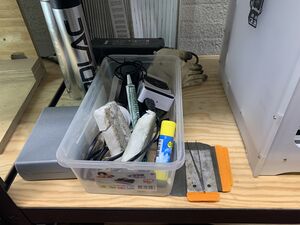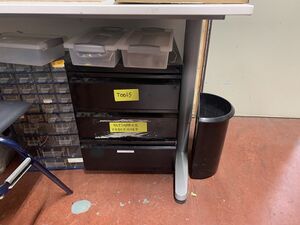Ultimaker 3D Printer
This equipment is safety category 3:
- Mandatory, in person, instructions.
- Make sure you read the Wiki before asking.
This equipment is Noise Category 3: Can be used at all hours. No limits.
This equipment can be left on overnight/ran unattended -- provided that the instructions on this page are followed to the letter.
Inhoud
[verbergen]Ultimaker printers
The Makerspace has three Ultimaker 3D printers, the Ultimaker2+, the Slightly higher Ultimaker2 extended+ and a Fancy Ultimakler 3 something with 2 nozzels. And one Bambu Lab 3D Printer.
The ultimaker 3 buildplate camera can be seen remotely through mijn.makerspaceleiden.nl (but only if it is actually switched on and running/printing).
Characteristics of the printers
| Property | Ultimaker 2+ | Ultimaker 2 Extended + |
|---|---|---|
| Max. size [mm] | 223x223x205 | 223x223x305 |
On the Ultimaker 3D printers using the default settings and the default nozzle, it is advised to only use 2.85mm filament.
Software
For the design of 3D models, the following software can be used:
- Open scad - Openscad is a open source software for creating solid 3D Cad objects (available on Wndows, MacOS and Unix/Linux). Openscad is a scripting language
- Fusion 360 Fusion 360 is an integrated CAD/CAM/CAE software to design 3D models. For personal use it is free of charge (available on Windows, MacOS)
- Tinkercad Tinkercad is a free, easy-to-use app for 3D design, electronics, and coding.
Any CAD software that is able to convert your design into a STL files is suitable for designing for or 3D printers. Alternatives are Sketch and Blender.
Also see: https://3dsolved.com/create-models-for-3d-printing/
Using a SD memory card
The Ultimaker printers at the Space need a GCODE file as input. You can put your GCODE files on a SD memory card and insert the memory card directly in one of the Ultimaker 3D printer. The memory cardslot is on the front of the printer.
- If you need to format your SD memory card (e.g. on MacOS), choose FAT32 and Master Boot Record (MBR) -- note that you need to expressly select FAT32; not the (new default) 'ExFAT'.
If you have a design file e.g. from Internet or a design program you need to convert your file, to the GCODE format or Ultimaker 3D printers can work with. STL is a common file file format and the easiest to to convert to GCODE. If you have a design in an other format it is possible to first convert this to the STL file format. Search with google for online conversion tools. (If you find a conversion tool, that gives good results, feel free to add URL here)
STL file can be converted into a GCODE by:
- Cura Cura is used to slice the model and prepare the GCODE (file extension .NGO)
- Slic3r Slic3r is used to slice the model and prepare the GCODE.
Using a laptop
There is also the option to directly print from your laptop, without using a memory card.
- PrintRun allows direct control of the printer and offer more opportunities than Cura/Slic3r. The GCODE file is uploaded via the USB connection on the backside of the printer.
The printing process
Once you have your printable GCODE file on a SD memory card, or your laptop ready and connected:
Preparing the printer
- Enter the SD card with GCODE file(s) into the SD card reader on the front panel of the 3D printer
- Prepare the print table for printing
- For PLA: Apply thin glue layer with glue stick
- For ABS: Use painters tape to cover printing area
- For PETG: Use glue from spray
- Switch on Ultimaker on the back side of the machine
Using the printer menu
For the next steps you use the rotary dial on the front of the printer.
- Turn the wheel to go to a menu item.
- Push the rotary dial to select (choose) a menu item.
Setting up the printer for printing and start printing
- Change material:
- To change material or the enter material in to the printer, choose Material in the main menu
- Choose Change. The machine heats up and first will remove existing material
- Choose Ready once material is removed
- Feeding new Material
- Feed new material on the back side of the UltiMaker
- Choose Ready once the material is transported through the tube. The material will be transported to the nozzle.
- Wait till material flows through nozzle and confirm by selecting Ready
Select material from the list. For PETG select PLA and apply settings mentioned above after the print assignment has been defined (see next step).
- Return to main menu by selection Return
- Select material from the list. For PETG select PLA and apply settings mentioned above.
- Start printing
- Select Print
- Choose the file you want to print. Modify the settings, when required. E.g. the settings for PETG as mentioned above. The printer heats up to the required temperature.
- Printing
- Once the nozzle and print table are at the required temperature, the printer will start.
- Printer releases small amount of filament through the nozzle
- The printer starts printing
- The display shows the expected time for the print
Post printing, aka removing your printed model and cleaning up
- Print ready
- Allow the printer table to cool down. Too early removal of the print may damage the print
- Remove the print from the print table. You can use the thin putty knife, from the box, to gently pry your print from the table
- Clean the printer table when required (remove glue / painter tape)
- Remove the Filament from the printer by executing step 3 of this procedure
- Once the filament is removed, switch off the print with the switch on the backside of the printer
- Store filament in the appropriate location
Settings
| Setting | PLA | ABS | PETG |
|---|---|---|---|
| Printing temperature | - | 250 °C | 240 °C |
| Printing table temp. | - | 110 °C | 60 °C |
| Printing speed | 60 mm/s | 25 mm/s | 30 mm/s |
| Fan speed | 100% | 20% | 30% |
Unattended running
The Ultimaker 3D printers are one of the few machines that can run unattended e.g. during the night.
Unattended printing only allowed when you follow these rules.
- Make sure you have enough filament on the spool and check that it won't tangle as it unrolls.
- Only print with Ultimaker listed and approved material. E.g. normal PLA, with normal settings.
- You stay with the printer for the first 10 layers or 15 minutes to check the printing process.
- You accept that other members have the right to remove your print, when it is finished or failed.
- Plan to remove your print soon after it is finished, e.g. the next morning when you print overnight.
Please leave a note with your name and email, so people can contact you, when something looks wrong, or want to know what you planning.
Cleaning the Ultimakers
Het komt ongeveer hier op neer:
- Maak de glij-assen schoon met een niet-pluizend absorberend papier (keukenpapier) en breng er een beetje verse (naaimachine) olie op aan. (dunne olie).
Voor meer informatie lees:
- Maak het trapeziumdraadeind schoon met niet-pluizend papier en breng een beetje verse magnalube aan (Het groene spul uit de Ultimaker-onderhoud la). (Dik siliconen? vet)
Verder kun je de glasplaat afwassen zoals je dat ook met een glazen ovenschaal zou doen (Afwasmiddel, heet water, sponsje, en niet laten vallen. Goed afdrogen alvorens terug te plaatsen).
Losse frutsels filament kun je met stoffer-en-blik of stofzuiger verwijderen, en met een zachte, niet pluizende doek (microvezeldoekje, evt. heel licht vochtig) kan de rest van de printer schoongemaakt worden.
In een bakje naast de UM3 vind je de spullen die nodig zijn voor normaal onderhoud.
In de ladekast onder de electronicatafel vind je een lade met onderdelen en accessoires voor de UMs
Atomic Pull: Releasing clocked material from nozzle
Important: If this is your first time performing this procedure make sure you are being supervised by an already experienced member.
Over time the printing nozzle can get clocked with filament. To clean the nozzle follow these steps:
- Remove remaining filament
- Get a 30cm of Nylon filament and straighten it as much as possible (there is a box with leftovers)
- Remove the blue horsehoe clip underneath the white coupling
- Remove the filament tube out of the print head, while holding the white coupling
- Select in the main menu "Advanced"
- Select "Heatup Nozzle"
- Raise the nozzle temperature to 260 degrees
- Once on right temperature, insert the straightened piece of filament into the nozzle
- Set the temperature to 90 degrees and wait for the printer to reach this temperature
- Pull out the filament, be aware, this may require substantial force
- Repeat this process as often as required
Recommended maintenance schedule
To keep your Ultimaker 2+ in optimal condition we recommend the following maintenance schedule, based on 1,500 printing hours per year:
| Every month | Every three months | Every Year |
|---|---|---|
| Clean Printer | Check for plays on axels | Clean feeder and replace Bowden tube |
| Lubricate axles | Check for tension of short belts | |
| Lubricate lead screw Z moto | ||
| Re-tighten hot end isolator |
Ultimaker fans
The fans on the UM2+ have been replaced on 28-02-2020. New fans ordered from | MakerPoint, "fan pack 1699".
Hotend fan was noisy after about 1500 / 1800 hours of printing.
| Ultimaker | Sunon | |
|---|---|---|
| Hotend fan | DF02500705BU-501 | mc25060VI-000u-A99 (5V / 0.58W Maglev) |
| Object fan | DF0301012BM-501 | ? |
These fans are the same for both Ultimakers.
source
Mail from deelnemerslijst:
De oude hotend fan (die herrie was gaan maken) is eentje met een Ultimaker stickertje erop, en nummer DF02500705BU-501 De oude object koel fans (2stuks) hebben nummer DF0301012BM-501 (Eveneens Ultimaker. Ze maken ze vast niet zelf, maar dit is hun opdruk) De nieuwe fannetjes komen uit het Ultimaker "Fan Pack 1699”, besteld bij makerpoint. De objectkoelfans zijn exact dezelfde, dezelfde nummers. De hotend fan is een Sunon Maglev mc25060VI-000u-A99 (5V / 0.58W). Daar staat verder op: F9620p en TP CLX.
Also Known As
3D Printing, Ultimakers, 3D Printen, 3D Printers.
Log
- 13-6-2016 X/Y axes lubed w. sewing machine oil.
- 13-6-2016 Z trapezoidal leadscrew w. magnalube G (incl. machine)
- 28-02-2020 Hotend fan replaced; object fans replaced; dust removed from fan duct; bed cleaned/re-glued. Uptime:3424:59 Printing:1797:11, material: 2103 m
- 21-09-2021 All 3 UMs cleaned and calibrated


